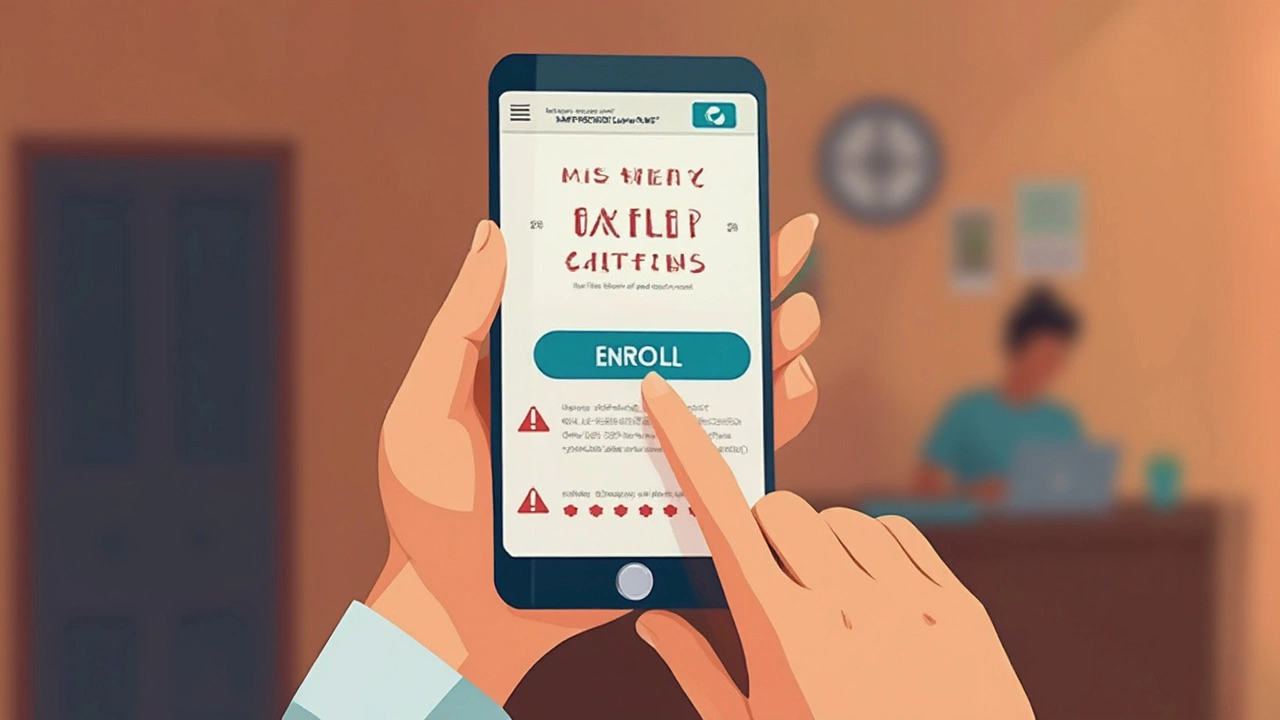If you’ve been scrolling course sites, you’ve probably spotted that big “FREE” badge. Sounds good, right? Just hit enroll and bam—you’re mastering Python, photography, or French. But hold on. If it seems too good to be true, there’s almost always a catch.
Most “free” online courses don’t start charging until you’re invested. Maybe you get the lessons, but then run into a paywall for quizzes or assignments. Or you finish the course and realize they want $50 for the certificate you thought was included. It’s kind of like my dog Paco sniffing out the treats—I’ve learned to expect a surprise hidden somewhere.
So are free courses ever really free? It depends on where you look and what you expect to get. The next sections will help you spot the sneaky fees and give you tricks for digging up the stuff that’s truly no-strings-attached.
- What Does ‘Free’ Actually Mean?
- Where The Costs Can Sneak Up
- What You Can Really Get for Free
- Tips for Truly Free Learning
- Is Paying Ever Worth It?
What Does ‘Free’ Actually Mean?
When a platform says a course is “free,” you have to dig deeper. Almost every major online course site—like Coursera, edX, and Udemy—uses the word “free” in more than one way. Usually, you get access to the video lessons without opening your wallet. But the extras? That’s where you might get hit with fees.
A quick look at the fine print shows most platforms break things up like this:
- Free access: Watch the video lectures and sometimes download reading materials.
- Pay for grading: Submit assignments or get feedback only if you pay.
- Pay for certificates: If you want proof for a job or your resume, you need to pay.
- Free trial: Some sites let you enroll for free for a week, then charge you if you forget to cancel.
Here’s a handy check of how popular platforms treat “free” courses:
| Platform | Lessons Free | Assignments Graded Free | Certificate Free |
|---|---|---|---|
| Coursera | Yes | No | No |
| edX | Yes | Sometimes | No |
| Udemy | Sometimes | Sometimes | Depends |
| Khan Academy | Yes | Yes | No certificates at all |
The most important thing here is that the word free online courses almost never covers everything—especially anything that needs grading, feedback, or paperwork. So, before you get too excited, check exactly what’s included. Usually, if you just want to learn for your own sake, you’re fine. But if you want to show someone you finished, that’s often when the bill shows up.
Where The Costs Can Sneak Up
You landed a free online course—that’s the win. But now comes the fine print. The truth is, even the biggest platforms pull out fees when you least expect them, and it’s usually not obvious until you’re halfway through. Here’s how they do it:
- Certificates and credentials: Sites like Coursera or edX let you watch all the videos for free, but charge anywhere from $20 to $199 for that shiny certificate or digital badge at the end. Some jobs won’t consider your new skills official unless you show this proof.
- Assignments and graded materials: You can binge-watch lessons, but if you want to submit homework, take quizzes, or peek at the answer keys, there’s often a paywall. Coursera’s “audit” option lets you see everything but locks out graded items.
- Access to instructors or support: Real help from teachers or community managers usually isn’t part of the free plan. Some platforms even charge for using basic forums or messaging tools.
- Time limits: That free access might only last while a course is “live.” Come back in six months, and you’ll need to pay to unlock the content again or download resources.
- Materials and textbooks: Bonus readings, downloadable workbooks, or required textbooks? They’re usually sold separately, and those costs add up. It’s not always clear until you’re inside the course.
Here’s a quick look at where extra fees can pop up on some well-known MOOC sites:
| Platform | Certificates | Graded Materials | Instructor Support |
|---|---|---|---|
| Coursera | $49/course | Paid | Paid |
| edX | $50–$300/course | Paid | Varies |
| FutureLearn | $39–$99 | Paid/Free for limited time | Paid |
The cost traps aren’t new, but they keep evolving. Watch for special offers, "free trials" that swap to monthly subscriptions, or “premium” content locked behind payment screens. These platforms make it easy to start learning, but they count on you valuing your progress enough to pay up when you hit these blocks. Keep your eye out for those little lock icons—they’re a dead giveaway there’s a fee hiding.

What You Can Really Get for Free
Here’s the real talk: a lot of platforms offer some pretty good stuff at absolutely no cost. But you’ve got to know the difference between what’s actually free and what’s just free bait. Let’s break down what you can expect to get with zero payment involved.
With most "free online courses," here’s what you truly get for nothing:
- Video lectures – You’ll almost always have access to course videos, sometimes even downloadable so you can watch offline.
- Reading material – Many classes on platforms like Coursera and edX provide full texts, articles, or downloadable PDFs at no cost.
- Discussion forums – Free learners can usually join class forums and connect with peers for help or networking.
- Practice quizzes – Some courses include ungraded quizzes to help you test your progress, but the graded stuff usually isn’t covered in the free zone.
To give you a real example, here’s a quick reference on what the big name platforms provide for free (as of early 2025):
| Platform | Free Access Includes | What Costs Extra |
|---|---|---|
| Coursera | All lectures, some assignments | Graded assignments, certificate |
| edX | Videos, readings, ungraded quizzes | Graded assessments, certificate |
| Udemy | Occasional free courses (limited selection) | Most courses, certificates |
| Khan Academy | Everything free | Nothing! (No paid upgrades) |
Khan Academy is the unicorn here—everything from videos to exercises is free, no credit card pop-ups. On Coursera and edX, you’ll often get access to all the material but miss out on certificates and feedback unless you pay. Udemy sometimes offers short-term freebies, but long-term, most interesting content will cost you.
Bottom line: You can learn a ton for free, especially if you care more about actually knowing the stuff than bragging about certificates on your LinkedIn. Just keep your eyes peeled—if “free” is your main goal, check the course details before getting too far in. Don’t want to be midway through a Python module when the paywall hits, trust me.
Tips for Truly Free Learning
If you want smart ways to avoid surprise fees and actually use free online courses for what they claim, let’s get into some real stuff you can do.
First, always check what’s included before you sign up. Most legit platforms are upfront, but you have to scroll past the giant “Enroll Free” button to spot the details. Look for phrases like “audit mode” or “access content only”—that means you’ll watch lectures but can’t get graded assignments or a certificate without paying.
Stick to well-known sources with good reputations for free content. Here are some standout picks:
- Khan Academy – 100% free with no catch, especially for math, science, and programming basics.
- MIT OpenCourseWare – You can access real college courses, no sign-up, no cost, just no official credit.
- Coursera (Audit Option) – Most courses let you watch lectures for free if you ignore assignments and don’t want the certificate. Always click “audit” if you don’t want to pay.
- edX (Audit Track) – Like Coursera. You get access to course materials, but graded stuff is extra.
- FutureLearn – Free for the course’s run time, but you lose access afterward unless you pay up.
Want to avoid surprises? Here’s a quick checklist:
- Search for reviews that mention hidden fees or tricky policies.
- Always read the FAQ or pricing section before creating an account.
- If a platform promotes a “free trial,” set a calendar reminder to cancel if it auto-renews at a cost.
- Look for community forums where past students talk about their real experiences (Reddit’s r/OnlineLearning is packed with first-hand info).
Here’s a handy snapshot of platform "free-ness:"
| Platform | Free Course Access? | Free Assignments? | Free Certificate? |
|---|---|---|---|
| Khan Academy | Yes | Yes | N/A |
| MIT OpenCourseWare | Yes | Yes | No |
| Coursera (Audit) | Yes | No | No |
| edX (Audit) | Yes | No | No |
| FutureLearn | Yes (during course) | No | No |
Even if you can’t get a certificate, showing off your new skills matters more, especially to employers who care about what you can actually do. If you want proof, you can always document your work with project portfolios or GitHub repos (for tech stuff). Bottom line: focus on learning, and you’ll dodge the gotchas.

Is Paying Ever Worth It?
Here's the real talk: tossing some cash at a course can be totally worth it—but only if you need something you can’t get for free. One of the biggest reasons people pay is for an official certificate. A lot of employers like to see proof you finished a course, especially if it’s from a big name like Coursera, edX, or Udemy. But it’s not just about the paper—you’re often paying for things like graded assignments, hands-on projects, and real feedback from instructors.
If you’re just learning for fun or to brush up on a skill, free courses might be enough. But if you’re job hunting, aiming for a career switch, or hoping to move up at work, a verified certificate can give your LinkedIn profile or resume an edge. FutureLearn, for example, says 44% of their paid learners saw a positive career impact after getting a certificate. That’s not nothing.
Check out how the main platforms stack up when it comes to paid features:
| Platform | Free Option | What You Get If You Pay |
|---|---|---|
| Coursera | View course videos | Graded assignments, certificate |
| edX | Audit content only | Graded work, certificate |
| Udemy | Rarely fully free | Lifetime access, projects, Q&A |
| LinkedIn Learning | Free trial only | All content, certificates, quizzes |
Sometimes, paying unlocks ways to learn smarter. You might get peer support, feedback, or even networking chances. But if money’s tight, you can always learn most free online courses content without the extras. My tip? Only pay if you need something specific—like graded work, formal recognition, or instructor help. Otherwise, skip the fee and grab all the free value you can.
